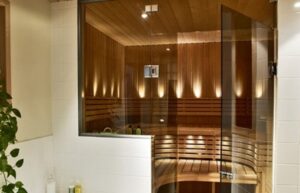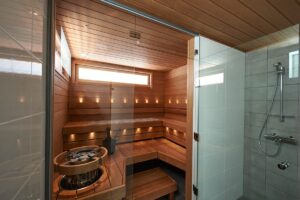How to keep your sauna panel clean and beautiful year after year
The secret to the longevity of your sauna panel is regular and gentle...
Read moreCorrectly designed and installed sauna glass wall does not detract from the baths, but is the key to creating a modern and spacious home spa. With the right glass quality, heater power and ventilation, the glass surface does not create a draughty feeling, but elegantly integrates the sauna into the bathroom while maintaining an excellent sauna experience.
The glass wall has become one of the most popular elements in the modern sauna – and for good reason. It adds light, space and seamlessly integrates the steam room into the bathroom interior. At the same time, an important question arises in the minds of many bathers: what does a large glass surface do to the sauna? Can a glass wall really provide the same soft, moist heat as a traditional log-walled sauna?
The concern is understandable, but mostly unnecessary. When the glass wall in your sauna is professionally installed, it is not an obstacle to a quality sauna experience, quite the contrary. It’s about managing the whole – the right kind of safety glass, a sufficiently efficient heater and its correct placement. These factors ensure that the heat is evenly distributed and there is no draught. Let’s look at how to ensure that your glass-walled sauna not only looks great, but also gives you the perfect sauna experience.

It is true that glass and wood behave differently with heat. Wood is an excellent insulator, storing heat and slowly releasing it back into the room. Glass, on the other hand, does not insulate in the same way, leading many to wonder whether it feels cool next to a glass wall or whether heat escapes through it. In a properly designed sauna, these are not problems, but manageable features.
The most important rule for a glass-walled sauna is the heater. Since glass surfaces do not store heat, the heater requires a little more power to compensate for heat loss. A good rule of thumb is to add one cubic metre for every square metre of glass to the calculated volume of the sauna. So if you have an 8-cubic-metre sauna with 2 square metres of glass wall, choose a heater designed for about 10 cubic metres.
Positioning is at least as important. When a heater is installed close to a glass wall, the radiant heat it emits heats the glass and the air in front of it. This creates a “thermal curtain” that effectively prevents draughts and ensures that the heat is pleasantly distributed throughout the room.
Good ventilation is the basis for quality sauna baths in all saunas, but its importance becomes even more important with a glass wall. Properly designed ventilation ensures that warm air circulates efficiently and does not just collect at the ceiling line. A replacement air valve is typically placed close to the heater at the floor line, and an exhaust air valve as far away from the heater as possible, often under the ceiling tiles or at the ceiling line. This controlled airflow mixes the air, distributes moisture evenly and ensures an enjoyable, oxygen-rich sauna experience in every corner.
Good ventilation is the lifeblood of any quality sauna. It ensures that the steam is rich and pleasant, and that the air circulates efficiently, heating the whole room. When installing a glass wall, special attention must be paid to the supply of replacement air, as glass itself is a completely sealed material. However, providing adequate ventilation is simple if you take this into account at the design stage.
The most common and usually the best way to ensure the supply of replacement air in a glass-walled sauna is to leave a deliberate air gap under the glass door or the entire glass element. This is a traditional method of gravity ventilation that has been proven to be very effective.
This solution is not only efficient, but also aesthetically pleasing. It does not require separate vents in the wall structures, and the sauna glass wall retains its minimalist look.
In some cases, a doorjamb alone is not sufficient or the best solution. A separate, wall-mounted replacement air valve should be considered if:
If a separate valve is chosen, it should be located on the wall, close to the floor and as close as possible to the heater. This will ensure that the incoming air mixes effectively with the warm airflow and does not create a draft for those sitting on the benches.
The question of energy consumption is perfectly valid. It is a physical fact that the insulating value (U-value) of glass is lower than that of a thick, insulated wooden wall. Does this mean that a glass-walled sauna is automatically a waste of energy, which is reflected in the electricity bill? The short answer is: no, when the overall design is right.

It is important to understand the scale at which we are talking. A home sauna is typically used for a few hours at a time, not continuously. Most of the energy is used to heat the sauna to the desired temperature, rather than to maintain the temperature. Although the glass surface radiates heat slightly more efficiently than wood, its impact on the total energy consumption of a single sauna session is very small.
As mentioned earlier, the solution is to size the stove correctly. When the heater’s output is matched to the additional heating required by the glass surfaces, the sauna heats up quickly and reaches the target temperature efficiently. A slightly more efficient heater does not necessarily consume more electricity, but does its job more quickly and maintains heat at a lower output, controlled by a thermostat.
In reality, the difference in electricity bills between a traditional sauna and a glass-walled sauna is usually marginal. We are probably talking about cents per sauna session, not euros. When you compare this small difference with the huge added value that a glass sauna wall brings to the aesthetics, light and sense of space in your home, it’s easy to see that it’s a worthwhile investment.
So it’s not about wasting energy, it’s about using it intelligently to achieve the desired result. A properly installed sauna glass wall made of high quality 8 mm tempered safety glass is a durable and timeless choice that will give you pleasure and atmosphere for decades.
A perfect stew is the sum of many factors. While the structure of the sauna, such as a beautiful glass wall, sets the scene for the experience, the quality of the sauna itself can be significantly influenced by a few simple practical tips. These tips apply to any sauna, whether it’s a traditional log cabin or a modern home spa.
One of the most common mistakes is to rush into the sauna as soon as the thermometer shows the desired reading. True sauna comfort is not just about hot air, but about warm structures. Allow the sauna to warm up in peace and quiet, so that the ceilings and wall surfaces have time to store heat. It is particularly important to let the stones of the stove heat up thoroughly. Properly annealed stones steam water efficiently and produce a soft, full-bodied steam.
Hearthstones are the heart of the sauna. They work hard when exposed to constant, high temperature fluctuations. Over time, the stones become weathered and crumble, blocking the air circulation in the heater and reducing the quality of the sauna baths. A good practice is to reload the stones at least once a year, removing crumbled material and broken stones at the same time. New, good quality and correctly sized stones will ensure that air can circulate freely and that the stove always produces the best possible fire.
Did you know that the temperature of the boiling water matters? Try using warm water instead of cold. Warm water evaporates more gently and richly on the stones, creating a moist and long-lasting cloud of steam. Cold water ‘scares’ the hot stones and can produce a sharper, more pungent steam. The method of throwing also plays a role. Avoid sudden, large splashes, preferring instead to pour gently over a wide area of rocks. This gives the water time to evaporate properly.
An excellent sauna experience is a balance between heat and humidity. The heat alone makes the air feel dry and even pungent. So always keep a bowl of water (a stove) in the sauna, even if you’re not actively throwing a sauna bath. Just having a water-filled stool helps to maintain a comfortable basic humidity level in the air, making the experience much more enjoyable.
Bring your ideas to life – try our free design tool and design the sauna of your dreams